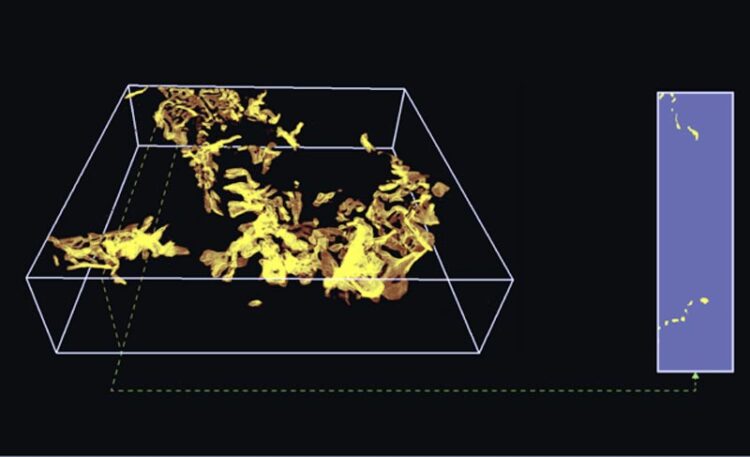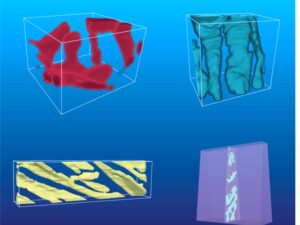Scientists identify new mechanism of corrosion

Molten salt corroded a metal barrier, appearing disconnected on a slice view of the damage (right). Researchers imaged the corrosion in 3D and reconstructed the path the salt took through metal (left).
Credit: Yang Yang/Penn State
Controlling one-dimensional wormhole corrosion could help advance power plant designs.
It started with a mystery: How did molten salt breach its metal container? Understanding the behavior of molten salt, a proposed coolant for next-generation nuclear reactors and fusion power, is a question of critical safety for advanced energy production. The multi-institutional research team, co-led by Penn State, initially imaged a cross-section of the sealed container, finding no clear pathway for the salt appearing on the outside. The researchers then used electron tomography, a 3D imaging technique, to reveal the tiniest of connected passages linking two sides of the solid container. That finding only led to more questions for the team investigating the strange phenomenon.
They published the answers on Feb. 22 in Nature Communications.
“Corrosion, a ubiquitous failure mode of materials, is traditionally measured in three dimensions or two dimensions, but those theories were not sufficient to explain the phenomenon in this case,” said co-corresponding author Yang Yang, assistant professor of engineering science and mechanics and of nuclear engineering at Penn State. He is also affiliated with the National Center for Electron Microscopy at Lawrence Berkeley National Laboratory, as well as the Materials Research Institute at Penn State. “We found that this penetrating corrosion was so localized, it only existed in one dimension — like a wormhole.”

Credit: Yang Yang/Penn State
Wormholes on Earth, unlike the hypothetical astrophysical phenomenon, are typically bored by insects like worms and beetles. They dig into the ground, wood or fruits, leaving one hole behind as they excavate an unseen labyrinth. The worm may return to the surface through a new hole. From the surface, it looks like the worm disappears at one point in space and time and reappears at another. Electron tomography could reveal the hidden tunnels of the molten salt’s route on a microscopic scale, whose morphology looks very similar to the wormholes.
To interrogate how the molten salt “digs” through metal, Yang and the team developed new tools and analysis approaches. According to Yang, their findings not only uncover a new mechanism of corrosion morphology, but also point to the potential of intentionally designing such structures to enable more advanced materials.
“Corrosion is often accelerated at specific sites due to various material defects and distinct local environments, but the detection, prediction and understanding of localized corrosion is extremely challenging,” said co-corresponding author Andrew M. Minor, professor of materials science and engineering at the University of California Berkeley and Lawrence Berkeley National Laboratory.
The team hypothesized that wormhole formation is linked to the exceptional concentration of vacancies — the empty sites that result from removing atoms — in the material. To prove this, the team combined 4D scanning transmission electron microscopy with theoretical calculations to identify the vacancies in the material. Together, this allowed the researchers to map vacancies in the atomic arrangement of the material at the nanometer scale. The resulting resolution is 10,000 times higher than conventional detection methods, Yang said.
“Materials are not perfect,” said co-corresponding author Michael Short, associate professor of nuclear science and engineering at the Massachusetts Institute of Technology (MIT). “They have vacancies, and the vacancy concentration increases as the material is heated, is irradiated or, in our case, undergoes corrosion. Typical vacancy concentrations are much less than the one caused by molten salt, which aggregates and serve as the precursor of the wormhole.”
Molten salt, which can be used as a reaction medium for materials synthesis, recycling solvent and more in addition to a nuclear reactor coolant, selectively removes atoms from the material during corrosion, forming the 1D wormholes along 2D defects, called grain boundaries, in the metal. The researchers found that molten salt filled the voids of various metal alloys in unique ways.
“Only after we know how the salt infiltrates can we intentionally control or use it,” said co-first author Weiyue Zhou, postdoctoral associate at MIT. “This is crucial for the safety of many advanced engineering systems.”
Now that the researchers better understand how the molten salt traverses specific metals — and how it changes depending on the salt and metal types — they said they hope to apply that physics to better predict the failure of materials and design more resistant materials.
“As a next step, we want to understand how this process evolves as a function of time and how we can capture the phenomenon with simulation to help understand the mechanisms,” said co-author Mia Jin, assistant professor of nuclear engineering at Penn State. “Once modeling and experiments can go hand-in-hand, it can be more efficient to learn how to make new materials to suppress this phenomenon when undesired and utilize it otherwise.”
Other contributors include co-authors Jim Ciston, M.C. Scott, Sheng Yin, Qin Yu, Robert O. Ritchie and Mark Asta, Lawrence Berkeley National Laboratory; co-authors Mingda Li and Ju Li, MIT; Sarah Y. Wang, Ya-Qian Zhang and Steven E. Zeltmann, University of California, Berkeley; Matthew J. Olszta and Daniel K. Schreiber, Pacific Northwest National Laboratory; and John R. Scully, University of Virginia. Minor, Scott, Ritchie and Asta are also affiliated with the University of California, Berkeley.
This work was primarily supported by FUTURE (Fundamental Understanding of Transport Under Reactor Extremes), an Energy Frontier Research Center funded by the Department of Energy, Office of Science, Basic Energy Sciences.
Journal: Nature Communications
DOI: 10.1038/s41467-023-36588-9
Method of Research: Experimental study
Article Title: One dimensional wormhole corrosion in metals
Article Publication Date: 22-Feb-2023
Media Contact
Adrienne Berard
Penn State
akb6884@psu.edu
All latest news from the category: Materials Sciences
Materials management deals with the research, development, manufacturing and processing of raw and industrial materials. Key aspects here are biological and medical issues, which play an increasingly important role in this field.
innovations-report offers in-depth articles related to the development and application of materials and the structure and properties of new materials.
Newest articles

A new class of cosmic X-ray sources discovered
An international team of astronomers, led by researchers from the Astronomical Observatory of the University of Warsaw, have identified a new class of cosmic X-ray sources. The findings have been…

An open solution to improving research reproducibility
Academic and industry scientists collaborate on a new method to characterize research antibodies. Structural Genomics Consortium researchers at The Neuro (Montreal Neurological Institute-Hospital) of McGill University, in collaboration with scientists…

Living in the deep, dark, slow lane
Insights from the first global appraisal of microbiomes in earth’s subsurface environments. Which microbes thrive below us in darkness – in gold mines, in aquifers, in deep boreholes in the…



